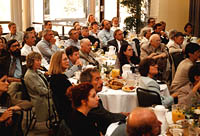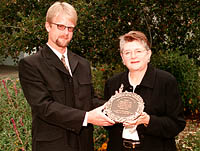
August 14, 2000
Top county leaders hear of campus achievements and plans for the future
By Jennifer McNulty
Dozens of Santa Cruz County community leaders turned out for a recent breakfast meeting
during which Chancellor Greenwood and other campus representatives detailed UCSC's
achievements and outlined plans for the future.
 |
| About 75 members of the Santa Cruz and UCSC communities attended a breakfast meeting in August. |
 |
| Michael Scheele of the American Society of Landscape Architects presented Chancellor
Greenwood with a medallion recognizing UCSC as one of the most beautiful sites in
the country. Photos: Victor Schiffrin |
Among the representatives of education and government who attended the gathering were Santa Cruz Mayor Keith Sugar and several members of the city council, County Superintendent of Schools Diane Siri, and Sheriff Mark Tracy. Representing the business community were Santa Cruz Area Chamber of Commerce Executive Director Michael Schmidt and Santa Cruz Business Council members Charles Canfield and Norman Lezin. The event, which was the first of its kind, drew about 75 invited guests.
The audience heard a two-part message that focused on the benefits the campus brings to the community and on the ways in which UCSC will grow in the next ten years.
"I can't think of anything more worth doing than helping the young people of this state get the education they need to become the leaders of our community and our nation," Greenwood said at the conclusion of the gathering.
The university remains the county's largest employer, with approximately 5,000 people on the payroll, including student workers. In 1998-99, the campus generated $328 million in annual expenditures that multiply to boost the county's economy by nearly $750 million. By comparison, agriculture generates $250 million for the county. UCSC is a more "efficient" economic engine, confining its activities to one-fourth of its 2,000-acre site, compared to the 35,000 acres devoted to agriculture, noted Greenwood.
But the campus's contributions to the community add up in noneconomic terms, too, said Greenwood. Based on the results of a recent survey of UCSC faculty, staff, and students, in which 80 percent of respondents said they volunteer in the community on a regular basis, Greenwood estimated that UCSC contributes about one million hours per year in volunteer service to the community.
"That's the equivalent of 429 full-time positions and approximately $11.8
million in salaries, if each individual received the county-average salary of $27,000
a year," she said.
That message of community participation was followed by Greenwood's request for greater
understanding and support of the campus as it grows to meet the specifications outlined
in the 1988 Long-Range Development Plan, which calls for an enrollment of 15,000
students within the next ten years. In addition, the campus has been asked by the
Office of the President to consider ways to accommodate another 1,900 students as
its share of "Tidal Wave II," the euphemism for more than 63,000 new UC
students that are expected to flood the system by 2010.
Greenwood said top administrators are pursuing several strategies to accommodate
greater enrollment while minimizing the impact on the Santa Cruz campus. These innovations
include:
- Enrolling more students in off-campus residential learning programs, such as the Education Abroad Program and UC's systemwide UCDC Program, which gives undergraduates an opportunity to study and work in Washington, D.C.
- Offering classes at the new UC Santa Cruz Silicon Valley Center
- Increasing distance-learning and summer course offerings
More students could aggravate an already tight housing market, but UCSC is pursuing
ambitious plans to provide beds for 10,000 students by the 2005-06 academic year.
Greenwood noted that only UCSC and UC San Diego house more than 25 percent of their
students on campus. UCSC currently provides space for about 50 percent of its students
and is aiming to accommodate 70 percent, she said.
Adding to the housing challenge is the anticipated hire of 600 new faculty in the
next ten years, 300 of whom will replace retiring faculty and 300 of whom will reflect
expanding academic programs, said Greenwood.
"We are building student housing as rapidly as we can, and faculty and staff
housing is also a high priority," said Greenwood. "To reach our aggressive
housing goals, we are going to need some community support."
Greenwood acknowledged that there has been friction between the campus and some members
of the community over university-related traffic, and she emphasized that, popular
myth notwithstanding, a recent traffic impact study showed that UCSC is not a major
contributor to traffic snarls on Highway 1 and on Mission Street east of Bay Street.
The university's greatest traffic impacts are on Western Drive, High Street east
of Bay Street, and Bay south of High, she noted. The success of the campus's growing
alternative transportation network is underscored by the fact that more than 50 percent
of all trips to and from the campus are by some means other than a single-occupant
vehicle.
A question-and-answer period followed presentations about academic programs by John
Simpson, campus provost and executive vice chancellor; Gary Griggs, professor of
Earth sciences and director of UCSC's Institute of Marine Sciences; Manuel Pastor,
professor of Latin American and Latino studies and director of UCSC's new Center
for Justice, Tolerance, and Community; and Jerry Nelson, professor of astronomy and
astrophysics and director of the Center for Adaptive Optics. J. Michael Thompson,
associate vice chancellor for outreach, admissions, and student academic services,
presented an overview of UCSC's educational outreach programs.
Thompson's presentation received praise from Diane Siri, county superintendent of
schools, who said UCSC's outreach programs are having a positive impact on students,
whose test scores are up and more of whom are graduating prepared to attend college.
"Every child can and should be aiming toward a post-high school education,"
said Greenwood, adding that 48 percent of UCSC students receive "significant"
financial aid, and 60 percent receive some assistance.
Also at the gathering, Greenwood accepted the Centennial Medallion from Michael Scheele,
representing the American Society of Landscape Architects. The award honored the
campus as one of the most beautiful sites in the country, reflected by its outstanding
integration of development and the natural environment.
Renowned landscape architect Thomas Church, who served on the campus's early planning
committee, wrote in a letter nominating the campus for the honor, that at UCSC, "the
buildings are less important than the visual composition and the trees." In
accepting the award, Greenwood said that the same commitment to stewardship of this
unique campus will continue as the campus grows.